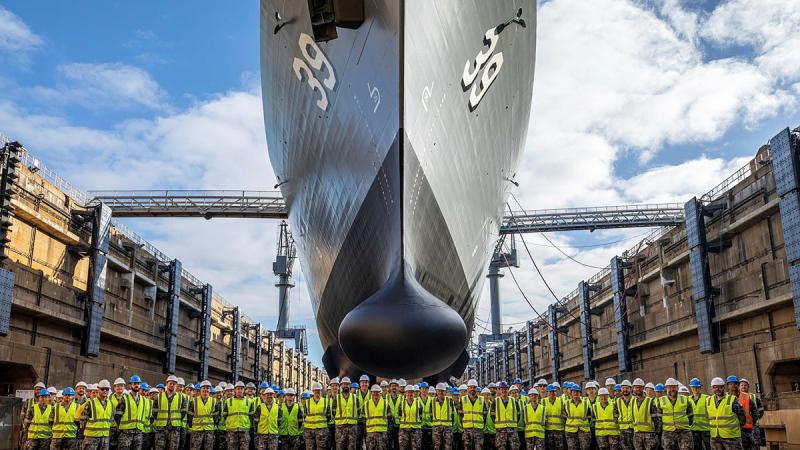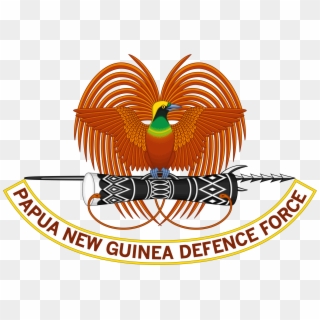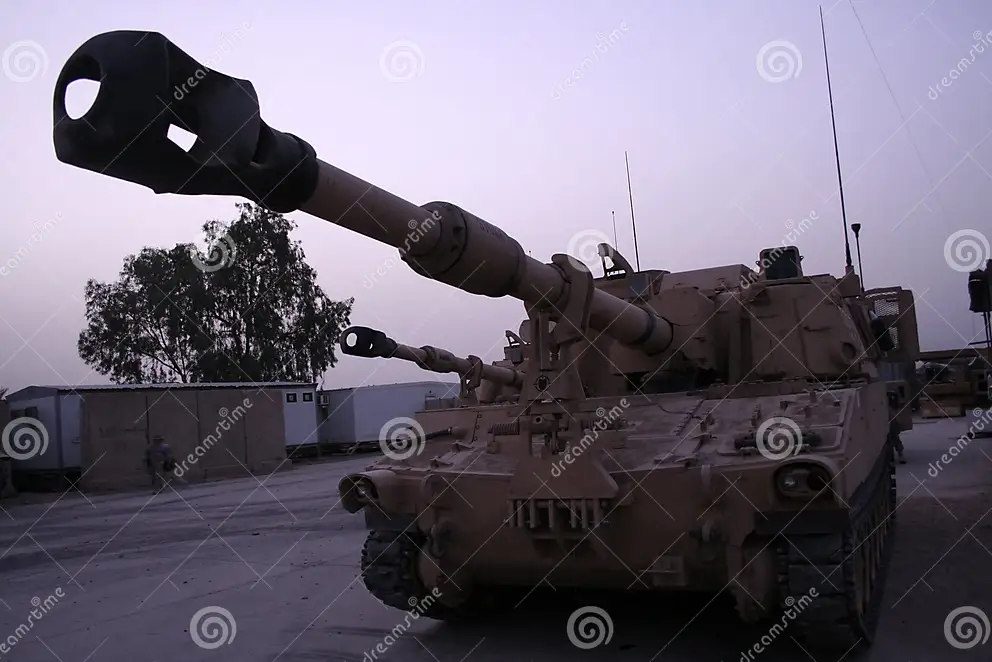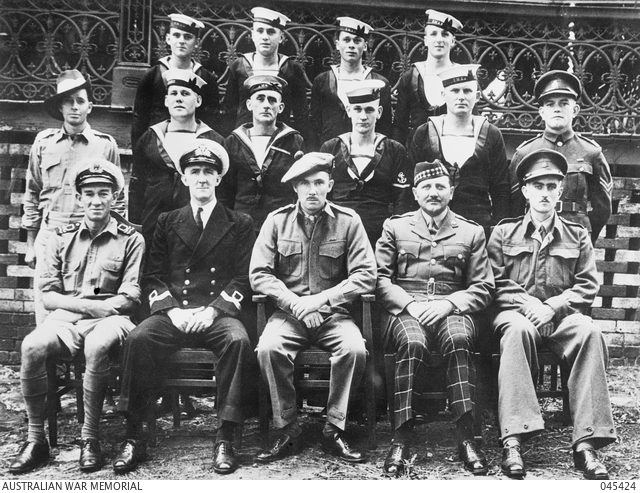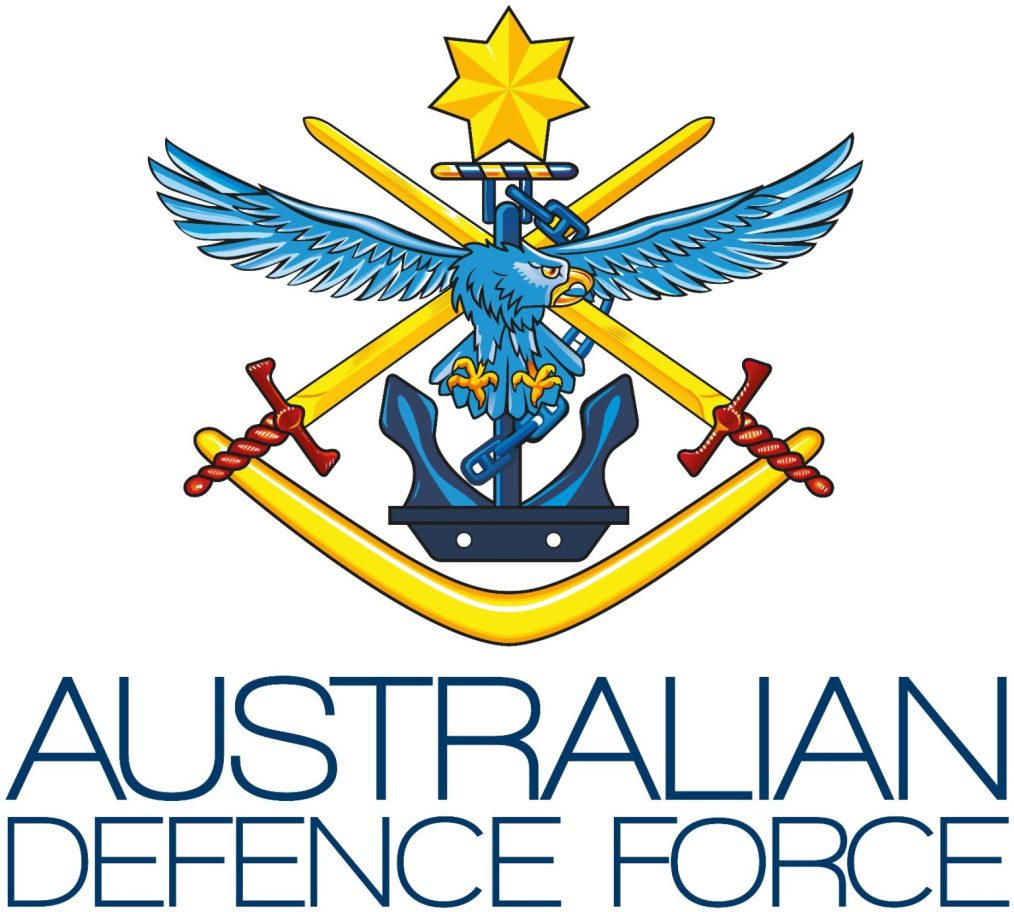Forward Air Controllers (FACs) were integral to America’s war effort in Vietnam, using various aircraft. One such aircraft—the Cessna O-2—was a modified civilian 337 Skymaster and flew a wide range of missions during the war. Then-Lt. Mike Jackson’s memoir Naked in Da Nang noted: “FACs…plodded along at ridiculously low levels to direct airstrikes, observe troop movements, gather intelligence, and/or choreograph search-and-rescue missions…we were the traffic cops of Southeast Asia, telling everyone where to go, when to go, how to get there, and what to do once they were there.”
The HMAS Hobart, fondly referred to as ‘the green ghost’, has been given an extensive renovation both internally and externally. This update marks a historic moment, making the ship the first of its kind – a Hobart-class guided missile destroyer – to undergo a docking selected restricted availability (DSRA) as a component of its routine maintenance and use cycle.
This rigorous maintenance phase took 20 weeks of consistent work, accounting for approximately 180,000 work hours. The process involved 3,800 isolations, opening 76 tanks, and issuing over 1,300 hot work permits.
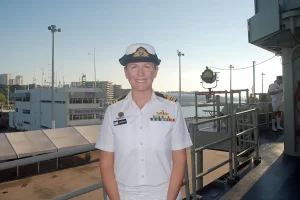 On September 25, the Commanding Officer of the Hobart, Commander Tina Brown, addressed the ship’s personnel and representatives of the destroyer enterprise. She expressed gratitude and acknowledged the immense planning, coordination, and execution efforts that went into the DSRA.
On September 25, the Commanding Officer of the Hobart, Commander Tina Brown, addressed the ship’s personnel and representatives of the destroyer enterprise. She expressed gratitude and acknowledged the immense planning, coordination, and execution efforts that went into the DSRA.
Commander Brown highlighted the intricate understanding of the system, resource allocation, and problem-solving capabilities required for a successful docking. “The remarkable results showcased the unmatched professionalism and expertise of both our technical sailors and our industry collaborators,” she remarked. She further added that the robust collaboration amongst enterprise partners truly embodied the “One Defence” principles.
Going forward, HMAS Hobart will shift its focus to meet force generation objectives, using the Sea Release Assurance Framework as a guide. The ship’s seaworthiness and combat readiness will be closely evaluated, ensuring it is primed for assignments in 2024.
Amidst the dense tropical backdrop of North Sulawesi, Indonesia, the Exercise Elang Ausindo was launched on September 18, marking a collaboration between the 75 Squadron and the Indonesian Air Force (TNI-AU).
This joint air combat initiative united six Australian RAAF F-35A Lightning II with an equal number of TNI-AU F-16 Fighting Falcons. Their collective aim? To hone and improve tactics related to air operations.
Remarkably, this marks the inaugural instance of RAAF F-35As participating in an exercise on Indonesian soil. The Air Attaché to Indonesia, Group Captain Kenneth Bowes, emphasized that this exercise marked three decades of joint military practices between Australian and Indonesian air forces, now recognized as the biennial Elang Ausindo series.
“There’s a rich tapestry of differences and similarities between our nations. Our shared objectives in regional security, given our proximity and camaraderie, are undeniable. Hence, it’s crucial for us to fly, train, and synergize in unison,” stated Group Captain Bowes.
The 75 Squadron F-35As undertook a journey through Japan, departing from RAAF Base Tindal, and were accompanied by approximately 150 skilled aviators to support the exercise.
Air Commodore Muhammad Mujib, who heads the Sam Ratulangi Air Force Base, articulated his belief that Exercise Elang Ausindo will pave the way for an even more robust partnership and mutual enhancement of capabilities for both air forces. He emphasized, “Participation in such exercises isn’t just beneficial in terms of new acquaintances or knowledge; it’s an investment in our shared future.”
Furthermore, the exercise introduced air-to-air refuelling, a recent feature of the Australia-Indonesia partnership, which saw its first execution in the previous month.
Group Captain Bowes, during the inauguration ceremony, reiterated the unwavering dedication of both RAAF and TNI-AU towards fortifying their partnership. He envisions not just the success of the current bilateral exercise but an amplified collaborative spirit in the times to come.
Tracing its origins back to 1993, Exercise Elang Ausindo is merely one facet of a broader air cooperation framework with Indonesia, which also encompasses Albatross Ausindo for maritime surveillance and Rajawali Ausindo for tactical airlift operations.
Top of Form
Specialist teams from the 3rd Combat Engineer Regiment, Papua New Guinea Defence Force (PNGDF), and the British Army have come together to refurbish residences at the Lombrum Naval Base on Manus Island.
Under the banner of Exercise Puk Puk, the combined forces managed to enhance 68 houses meant for PNGDF families and undertook significant road maintenance in the vicinity. The central aim was not only to rectify existing flaws in these homes to guarantee the security of the families but also to boost trade proficiency and foster knowledge exchange among the allied troops.
Lance Corporal Raimee Brook, who supervised the operations, mentioned a recent electrical mishap in one of the local homes. “After addressing the immediate issue, our focus shifted to rectifying potential risks in other properties, particularly concerning the electrical switchboards,” she remarked. Brook also shed light on the general wear and tear in these homes, with frequent relocations causing damages like power outlets dislodging from walls. The team is also revamping other parts of the naval base, including stair and deck replacements.
Brook emphasized the value of the collaboration with PNGDF professionals, finding it immensely fulfilling. “One of our local partners, Laurie, has immensely benefited from our Australian experts. He’s picking up diverse skills which he plans to apply back in his hometown, Lae,” Brook added. “The mutual cooperation has been heartwarming. Beyond the technical work, the support and love we’ve received from the community, especially the children, have been touching. They frequently come around, assisting us and even sharing fresh fruits.”
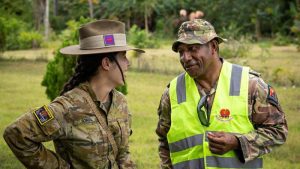 Lieutenant Robert Paka of the PNGDF expressed his appreciation for the collective venture. “This initiative primarily revolves around cross-national synergy, enabling forces from various nations to converge and exchange insights,” Lieutenant Paka stated. “Interacting with our colleagues from Australia and the UK has been an invigorating experience.”
Lieutenant Robert Paka of the PNGDF expressed his appreciation for the collective venture. “This initiative primarily revolves around cross-national synergy, enabling forces from various nations to converge and exchange insights,” Lieutenant Paka stated. “Interacting with our colleagues from Australia and the UK has been an invigorating experience.”
- The Paladin M109A6 is a self-propelled howitzer (SPH) cannon artillery system, produced by the ground system division of United Defense LP, now known as BAE Systems Land and Armaments. First fielded in 1994, the system is used by the US Army, Israeli Army, and has been acquired by Kuwait and Taiwan. By June 1999, the US Army had received 950 units, with additional units procured in the subsequent years. The first M109A7 upgraded from the M109A6 standard was delivered to the US Army in April 2015.
- Operational Features: A crew of four operates the Paladin, comprising a commander, driver, gunner, and loader. This team can autonomously receive mission details, compute firing data, set the cannon, fire, and relocate to a new position, demonstrating its ‘shoot and scoot’ capability. This ability allows them to fire the first round within 60 seconds, safeguarding the team from counterattacks. The Paladin played a crucial role in Operation Iraqi Freedom and other subsequent operations in Iraq.
- Armament Details: The Paladin is equipped with a 39-calibre 155mm M284 cannon, capable of reaching distances between 24km to 30km depending on the ammunition used. With an automatic fire control system and integrated inertial positioning and navigation, it can achieve a high firing rate, making it a formidable artillery system. Additionally, it’s being updated to fire the Excalibur projectile which boasts a range of 40km and exceptional accuracy.
- Protection Features: The Paladin’s design focuses on crew safety. The team stays inside the vehicle throughout missions, benefiting from nuclear, chemical, and biological protection systems. Additional enhancements include temperature-regulated air and Kevlar lining in the turret for added ballistic protection.
- Communication Suite: Paladin’s communications setup is top-notch, incorporating a secure voice and digital system, inclusive of the VIC-1 Intercom and the SINCGARS radio subsystem.
- Vehicle Propulsion and Power: Propelled by a 440hp diesel engine from Detroit Diesel Corporation, the Paladin can reach a top speed of 40mph and has a range of 214 miles. An electrical power supply rated at 650A, 24V DC supports the system’s operations.
- M109A7 Development and Delivery: The successor to the M109A6, the M109A7, was first introduced as a prototype in 2007. The US Army has plans to acquire a total of 580 sets of this artillery system. With several contracts awarded over the years for production sets, BAE Systems has been fulfilling the orders, transitioning from low-rate initial production to full-rate production.
- Upgrades and Improvements: BAE Systems and the US Army initiated the Paladin Integrated Management (PIM) program to enhance the Paladin system. The upgrade maintains key elements but introduces a Bradley-common chassis, a new 600hp engine, improved suspension, steering, survivability, and an automated loader. Enhanced digital capabilities and power-generation systems have been integrated, ensuring adaptability for future battlefield requirements. The firepower of the M109A7 is also doubled with a longer gun barrel and is fitted with the extended-range cannon artillery (ERCA) system.
Today, we commemorate the 80th anniversary of a pivotal event during World War II – Operation Jaywick. Orchestrated by the Z Special Unit, a joint venture between Australian and British special forces, this covert mission’s primary objective was to sabotage Japanese shipping activities in Singapore Harbour. Its success not only highlighted the potency of guerrilla warfare but also dealt a severe blow to the Japanese war effort, simultaneously elevating the spirits of the Allied forces.
Journey to the Heart of the Enemy Territory
Under the leadership of Major Ivor Lyon, the team embarked on a perilous journey from Western Australia towards Singapore. Their choice of transportation was an ingeniously captured boat, which they renamed the MV Krait to blend seamlessly into the local scenario. Disguised as Malay fishermen, the group sailed with the dual purpose of maintaining cover and avoiding unwanted attention.
Their journey led them to Subor Island, located a mere 11 kilometres from Singapore. Here, they prepared for the mission’s most critical phase.
The Night That Shifted the Tide of War
On the fateful night of 26th September 1943, the team, equipped with folding kayaks, silently infiltrated the Japanese-occupied Singapore Harbour. Their mission was simple yet audacious: place limpet mines on the Japanese ships without getting caught. After completing their treacherous task, they faced yet another challenge – paddling an arduous 80 kilometres to meet the MV Krait, their rendezvous point, which took them six days.
The result of their bravery became evident a few days later. The detonation of the limpet mines caused catastrophic damage. Seven enemy vessels, crucial to the Japanese naval operations, either sank or suffered grievous damages.
Homeward Bound: The Heroes Return
After successfully completing one of the most daring missions of World War II, the team rendezvoused with the Krait. Exhausted but triumphant, they embarked on their journey back home. The Krait, carrying its brave canoeists, made its way back to Australian shores, reaching Exmouth on 19th October 1943.
Legacy of Operation Jaywick
The audaciousness of Operation Jaywick remains a testament to the effectiveness of unconventional warfare. This mission not only demonstrated the strategic brilliance and courage of the Allied forces but also delivered a significant blow to the Japanese, disrupting their naval capabilities. Moreover, the news of the operation’s success spread rapidly among the Allies, serving as a morale booster during challenging times.
Today, as we remember and honour the heroes of Operation Jaywick, their legacy stands as a reminder of the indomitable human spirit and the lengths brave souls will go to ensure victory and freedom.
Images: Group portrait taken after the completion of Operation Jaywick (Australian War Memorial), The original sign for The Krait on display in The Man From Snowy River Museum in Corryong, photo courtesy of Carl Webster.
The Defence Department has recently expressed concerns regarding its increasing dependency on outsourced contractors, prompting strategic moves to bolster its internal staffing. Recent data, sourced through Freedom of Information laws, reveals that the contractor workforce has surged to an unprecedented 37,000 members. Alarmingly, this number surpasses the Australian Army’s enlisted personnel by 18 per cent, raising eyebrows about the Department’s operational sustainability and potential vulnerabilities.
Recognising the growing imbalance and potential risks of an outsized contractor workforce, the Department has clearly articulated its intentions to scale back on outsourcing. A significant part of this strategy is their ambitious commitment to reducing the size of its contracted workforce. In line with this vision, the Department has mapped out comprehensive plans that will:
- Transition 2,000 contractor roles to in-house positions by the end of next year. This move aims to directly integrate external roles, ensuring greater oversight, cohesion, and reliability in key operational areas.
- Expand the Department’s permanent staff base by a staggering 18,000 individuals by the year 2040. This long-term vision not only underscores the Department’s dedication to fortifying its internal resources but also highlights a commitment to providing stable employment and strengthening the core of its operational capacities.
This strategic shift is expected to offer numerous advantages, including better control over training, streamlined operations, enhanced security protocols, and reduced costs in the long run. By prioritising a robust internal workforce, the Defence Department aims to ensure that it remains resilient, self-reliant, and better poised to address the nation’s defence needs in an ever-evolving global landscape.
Will Shackel is the 17-year-old founder of Australia’s first youth-lead campaign for Nuclear Energy: Nuclear for Australia. As a young person concerned about the climate and energy crisis, he decided to research the prospect of the technology collaborating with experts from around the world, determining that nuclear power could be a solution that could benefit Australia.
Through his advocacy he started a petition to legalise Nuclear Energy, sent a letter to the Prime Minister and in May provided evidence to an Australian Senate Committee in Canberra on why he believed Nuclear Energy should be legalised.
In addition to his advocacy, last year he was a winner of Australia’s most prestigious academic competition: The Simpson Prize.
Phuoc Tuy – 1971: a US view of ‘fun-loving’ Australians, their “incredible exploits’, giant lobsters, and ‘not too many Viet Cong’
Perhaps this interesting view by a newly-arrived US captain on Phuoc Tuy Province in 1971 – and the “fun-loving Australians”, might be of interest to the readers of your FRONTLINE website?
A newly-arrived US Officer’s View of Phoenix in Phước Tuy in early 1971 (from p.250 in Chamberlain’s book on the VC underground)
In early 1971, US Army Captain Stuart Herrington arrived in Vietnam to serve as a Phoenix program advisor. Post-War, he described his arrival and allotment to the program:
“Three days in Saigon convinced me that I didn’t want to draw an assignment there. The city was filthy, overcrowded, hectic, and overrun with hustlers of all types. You name the negative modifier, it fit Saigon in early 1971. Not even the graffiti on the latrine walls at the reception centre could dampen my enthusiasm for getting out of Saigon – the sooner the better. … (a pejorative on Vietnamese and their flag has been omitted from this text) … I had a game plan to get a good assignment, if indeed there was such a thing in Vietnam.
A friend of mine had just returned from a tour in Phuoc Tuy, a coastal province southeast of Saigon best known for its resort town of Vung Tau. He had described duty in Phuoc Tuy in glowing terms—silver beaches, giant lobsters, and not too many Vietcong. There was even a contingent of fun-loving Australians stationed in the province, and my friend told incredible tales of their non-military exploits.
The plan was for me to go to the officer assignment folks at headquarters ((in Saigon)), rattle off a few words of Vietnamese, and Vung Tau, here I come. It didn’t work. The sergeant in the assignments branch merely laughed as he explained that Phuoc Tuy province would not hold all of the men who had volunteered to go there in the defence of democracy. The best I was able to do was to wrangle orders to Military Region III, the area around Saigon. I was to report the following morning to Bien Hoa city, a few miles north of Saigon, for an interview with a colonel who would decide where I would actually be assigned.”
Captain Herrington was assigned to the Phoenix program in Hậu Nghĩa Province – (40km west of Saigon via Route 22) until late 1972.
Regards, Ernie Chamberlain
Documentary 45min.
The Lockheed SR-71 “Blackbird” is a long-range, high-altitude, Mach 3+ strategic reconnaissance aircraft developed and manufactured by the American aerospace company Lockheed Corporation. It was operated by both the United States Air Force (USAF) and NASA. Just do a sr71a blackbird speed check! The SR-71 was developed as a black project from the Lockheed A-12 reconnaissance aircraft during the 1960s by Lockheed’s Skunk Works division. American aerospace engineer Clarence “Kelly” Johnson was responsible for many of the aircraft’s innovative concepts. The shape of the SR-71 was based on that of the A-12, which was one of the first aircraft to be designed with a reduced radar cross-section. At one point, a bomber variant of the aircraft was under consideration, before the program was focused solely on reconnaissance. Mission equipment for the reconnaissance role included signals intelligence sensors, a side-looking airborne radar, and a photo camera; the SR-71 was both longer and heavier than the A-12, allowing it to hold more fuel as well as a two-seat cockpit. The SR-71 designation has been attributed to lobbying efforts by USAF Chief of Staff General Curtis LeMay, who preferred the SR (Strategic Reconnaissance) designation over simply RS (Reconnaissance, Strategic). The aircraft was introduced to operational service in January 1966.


